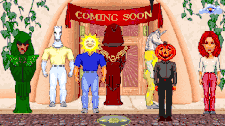WorldsAway
 A new locale opening in the world of Dreamscape circa 1996. | |
| Developer(s) | Fujitsu, LucasArts |
|---|---|
| Initial release | September 1995[1] |
| Written in | C++ / Tcl |
| Operating system | Microsoft Windows, Mac OS |
| Type | Virtual Communities |
| Website | www.VZones.com |
WorldsAway is an online graphical "virtual chat"[2] environment in which users designed their own two dimensionally represented avatars.[3][4] It was one of the first visual virtual worlds.[2] In 1996 it was one of the top 20 most popular forums on Compuserve.[5]
History
WorldsAway was an English version of Fujitsu and LucasArts' Habitat for the Commodore 64. Habitat was launched in 1986 and was the first online virtual world. WorldsAway was originally launched in 1995 through CompuServe[6] as a premium service for members. The world was called Dreamscape[1] and moved to the public Internet in 1997 still under the operation of Fujitsu.
As CompuServe morphed into AOL's "value brand", Fujitsu sought to sell off its product as they were making a loss. Inworlds.com (who later became Avaterra, Inc) stepped up and bought the licensing rights and took over the reins. As of 2011 the Dreamscape is still surviving independently as one of the VZones.com worlds – owned by Stratagem Corporation. Other WorldsAway worlds using the same server software that have been launched during Stratagem times are newHorizone, Seducity, Second Kingdom and Datylus. Stratagem Corporation The VZones worlds closed in August 2014 and re-opened in BETA under new ownership in 2017.
Gameplay
WorldsAway users would login, first only via dial-up Compuserve accounts, later via the public internet. First-time users would choose their gender, name, head and body style on a virtual ship before entering the world proper to meet other online users (these could be changed later by paying a quantity of tokens).[7]
Each subscriber would view and manipulate their own avatar which was displayed in a limited set of poses and profiles.[4] A user would walk their avatar around a virtual city (named Kymer), enter shops and teleporter cabins, gesture or chat to other avatars (cartoon like text bubbles would appear), and carry out various in-game actions.[2][4] Ty Burr's 1996 review of the three graphical chat worlds then available (the others were Worlds Chat and Time Warner's The Palace) rated WorldsAway the lowest at C+, criticizing the slowness and lack of flexibility.[2]
Unlike some modern virtual worlds, WorldsAway did not boast 3D graphics or any combat system (although inworld combat had been planned, it was never implemented).[8] Most time spent in the world by users was spent on economic endeavors and chat. Which meant that the world had a monetary token system and virtual business endeavors could be set up such as Clover's famous auctions with commissions for sales, or Dennis S's nightclub with admission charges, or the payments for the various street games such as bingo. The token system facilitated the economy. Avatars received tokens based on the number of hours played, from sales of objects, from gifts, and other sources such as running enterprises. Rare and/or functional objects were introduced into the world by stores and Acolytes. Acolytes were appointed by the Oracles and had access to changing supplies of objects that they gave away or awarded as prizes to the community. Clover's famous auctions were held weekly and people bid vast amounts of tokens to acquire rare items such as heads, clothing, furniture, and other useful or artistic objects. Apartments could be purchased, furnished, or sold. Other popular past-times were playing Bingo[2] and other simple games. These games were not a part of the original software; however, were made by third party developers as plug-ins.[8]
See also
References
- 1 2 Rossney
- 1 2 3 4 5 Ty Burr
- ↑ Bruce Damer
- 1 2 3 Steve Homer
- ↑ Business Week
- ↑ Remembering 1.x, Lizard Man, November 3rd, 1998
- ↑ Voyage on the Argo: Joining the Dreamscape Community, Bruce Damer
- 1 2 Gullible's Travels: Through the Dreamscape, Bruce Damer, Avatars!, "This is not a shoot-em-up world"
Bibliography
- ^ Bruce Damer (1997). "WorldsAway". digitalspace.com. Retrieved 2008-02-25.
Depth 2 1/2-D
- ^ Ty Burr (1996-05-03). "The Palace; Worldsaway; Worlds Chat". Entertainment Weekly. Archived from the original on 2008-08-30. Retrieved 2008-02-25.
- ^ Steve Homer (1996-06-17). "Nothing on telly? There will be". The Independent. Archived from the original on 2013-07-09. Retrieved 2008-02-25.
online chat system that allows users to adopt personalities through avatars, surrogate graphic characters which appear on screen. As people "talk" (by typing on their keyboards) words appear in speech bubbles.
- ^ Steven V. Brull; Robert D. Hof; Julia Flynn; Neil Gross (1996-03-18). "FUJITSU GETS WIRED (int'l edition)". Business Week. Archived from the original on 2008-07-06. Retrieved 2008-02-25.
More than 15,000 subscribers, intrigued by this extension of "chat", log on via CompuServe in 147 countries around the world.
- ^ Robert Rossney (June 1996). "Metaworlds" (4.06). Wired. Retrieved 2008-02-26.
External links
- VZones Website
- VZones Network Archives archives of locales, screenshots and info from 1995 to 2003
- WorldsAway Graphics archived screenshots from 1996